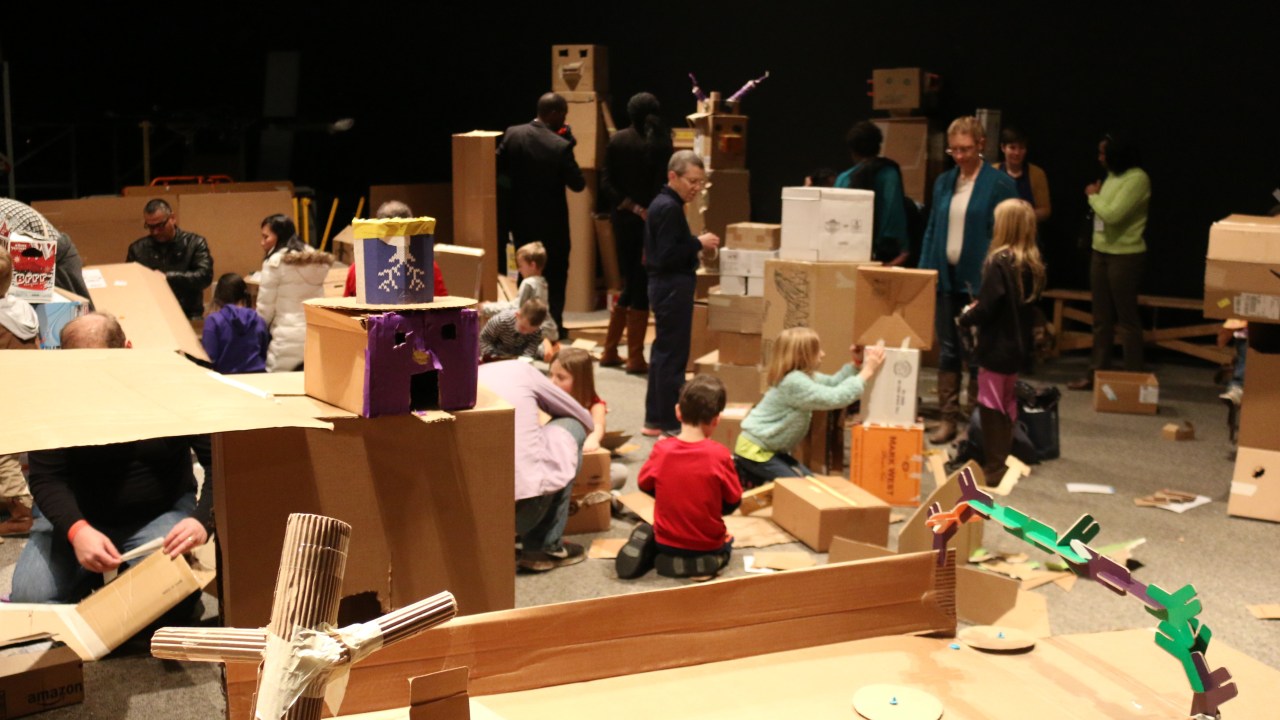
This article first appeared in the journal Exhibition (Spring 2023) Vol. 42 No. 1 and is reproduced with permission. www.name-aam.org. If you don’t read the journal, learn how you can subscribe to Exhibition to receive your copy of the full upcoming issues.
Origin Story
Cardboard has always been a popular material for kids to explore–at home, at summer camps, and at museums. Its availability combined with its ability to both hold its shape and be cut and manipulated have made cardboard an ideal material for imaginations for decades. That it sometimes comes shaped into a box you (or your cat) can sit in is a bonus. At the Science Museum of Minnesota (SMM), where both authors once worked, cardboard activities made frequent appearances in tabletop activities both at the museum and out in the community. In these contexts, the versatility and familiarity of cardboard often encouraged participants to go beyond the activity’s instructions. Embellishments, personalization, and modifications were frequent.
This high level of engagement with cardboard eventually led SMM to host a “Cardboard Day,” which coincided with Global Cardboard Challenge’s “Day of Play” in 2015. The Global Cardboard Challenge is an annual celebration of creativity inspired by the short film, Caine’s Arcade.[1] At our Cardboard Day, there were a dozen or so cardboard-based activities spread throughout the museum. One of these “activities” was a 2,000-square-foot room equipped with tape and scissors and a giant pile of previously used cardboard boxes where visitors could free-build whatever they wanted. It was a major shift from the highly designed experiences found elsewhere in the museum, and visitors loved it. They embraced the open-ended invitation to create and play, which supported long dwell times, deep in-group discussions, and significant mess.
Encouraged by what we saw, we devised an experiment: fill 4,000 square feet of unused temporary exhibition space with cardboard, tape, and scissors and watch what happens. For four consecutive weekends, visitors played with hundreds of used cardboard boxes while we observed, learned, and spent hours hauling cardboard used beyond reuse to the compactor. Based on the enthusiastic response, we hatched a plan: open Cardboard Gallery as a three-month temporary exhibition.
Trust and Broad Internal Engagement
Produced with a total budget of just over $10,000, the 4,000-square-foot Cardboard Gallery temporary exhibition became a reality in 2016 thanks to several important factors and relationships:
- First, there was a high degree of trust and support for calculated risks among the staff who were proposing Cardboard Gallery, the Exhibits Department, and the museum’s senior leader who oversaw both these areas. The advocate on the Senior Team had participated in Cardboard Day, observed visitors and their reaction to the free-build space, and understood the potential.
- Second, the entire museum was invited to participate by contributing boxes. For weeks prior to the opening and throughout the exhibition’s run, staff brought in their (unflattened) boxes and saved the boxes they generated at work. Organization-wide participation generated interest and investment in Cardboard Gallery.
- Finally, just as we needed to build trust at the top of the organization, we also needed to engage with and gain the buy-in and trust of both the front-line staff and volunteers who were to be working with visitors and managing the space and the facilities staff responsible for recycling the huge volumes of used-up cardboard. At the end of Cardboard Gallery’s initial run, the input of these two groups of staff was not only instrumental in making needed changes to improve future iterations but also in applying for grant funding.
We Didn’t Think They’d Do That!
Cardboard Gallery opened with minimal marketing opposite a “typical” 5,000-square-foot traveling exhibition in the fall of 2016 (fig. 1). As we had observed in earlier iterations, the dwell time was significant and inter-group cooperation and conversation soared as caregivers followed the lead of the kids they were with. Adults relived cardboard play from years or decades past. One of the authors overheard one child say to another as they walked in, “This is the room where all our dreams are going to come true!” It was fantastic and exciting. It was also a little out of control. In such an open-ended space, some things visitors did took us by surprise. One notable example was when visitors started moving their creativity to the walls of the gallery, using the provided multicolored painter’s tape to write their names and create designs (fig. 2). Although our initial reaction was to take it all down each night, after a few days we decided to let it go. This wall art was another way in which visitors were creating open-ended experiences in the gallery, and it allowed them to make the space their own in ways that were off limits in other parts of the museum (fig. 3).
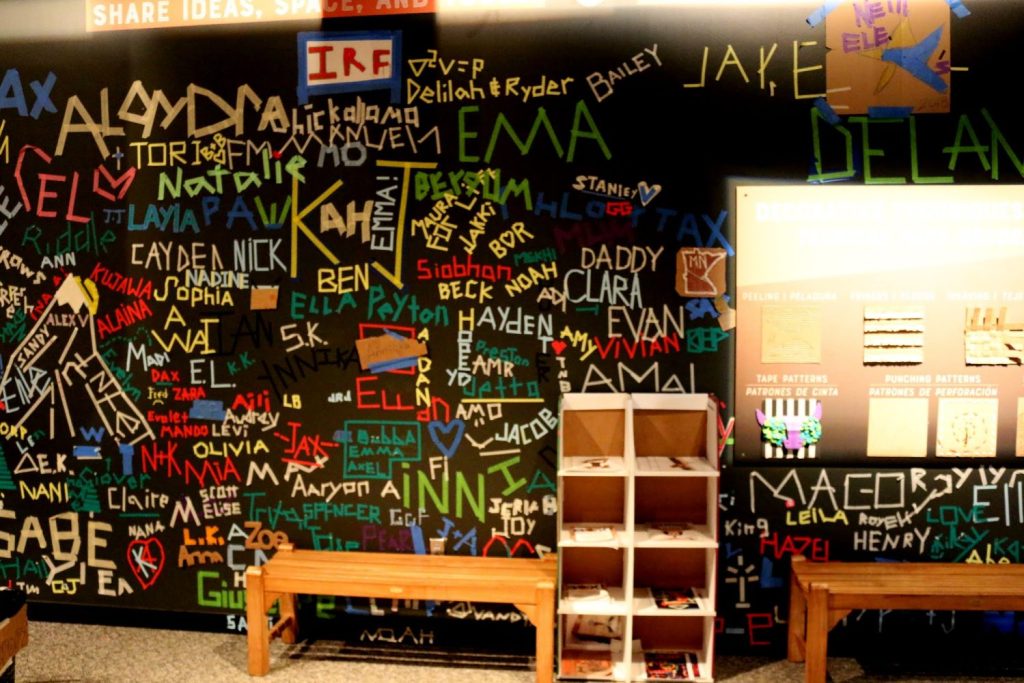
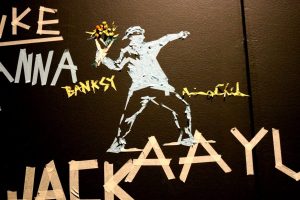
Another surprise was the amount of mess. We understood that the exhibition would entail significant cleaning and deconstruction, but the amount of scrap cardboard—pieces that were one to four inches in size—was far more than we expected, and more than floor staff could easily stay on top of. We assumed that visitors would waste cardboard by using only larger pieces, but they used small pieces as well, and as each use decreased a piece’s size, some unused scrap was inevitably created. These small bits were very hard to keep up with, and, in the end, we had to agree to a level of disarray in the exhibition that we did not allow in any other area of the museum. (In the next iteration of Cardboard Gallery, in 2018, we even tried using leaf blowers and snow shovels to help manage the waste, but both proved ineffective as the cardboard scraps clung to the carpet.) When we let go of our desire to maintain a pristine space, we learned that a certain level of messiness actually encouraged folks to participate (fig. 4). Maintaining the right level of messiness, however, was tricky: if the “creative mess” became a “chaos room,” then the mess became a detractor. Evaluation data showed us that maintaining examples of previous visitors’ work–both simple and complex–served as an even stronger motivation for creativity. As a result, floor staff became dramaturges, working to find the right level of messiness to encourage participation and saving and staging examples for inspiration.
By the Numbers
Cardboard Gallery cost just over $2.50 per square foot to produce. Our internal graphic design and production team created the minimal signage that the exhibition required. Almost all the cardboard–literally thousands of boxes–was provided by SMM staff who saved boxes “naturally” generated by the museum and who brought in boxes from home. We initially purchased some flat sheets but learned early on that visitors were much more interested in starting with something box shaped. We also purchased a number of boxes that we set up as an “analog Minecraft” area. Some visitors loved building with these boxes. Many others loved knocking them down–frequently while builders were still building. These competing agendas created some tense moments in the gallery, so we moved away from analog Minecraft and added those boxes to the general free-build pile, too.
We anticipated that tape would be a “big” expense, but donations from a local manufacturer offset those costs considerably. We experimented with different cutting tools that were both productive and safe, such as bandage scissors (the kind that are used in first-aid kits) and Klever Kutter® box cutters. Klever Kutters® have a permanently shielded blade, virtually eliminating the risk of visitor injuries. We also provided yarn for a short period of time but stopped because we found that it was rarely used. We experimented with drawing and writing supplies–quickly moving away from markers, as the caps tended to get lost causing the markers to dry out and go to waste–learning over time that large crayons worked best.
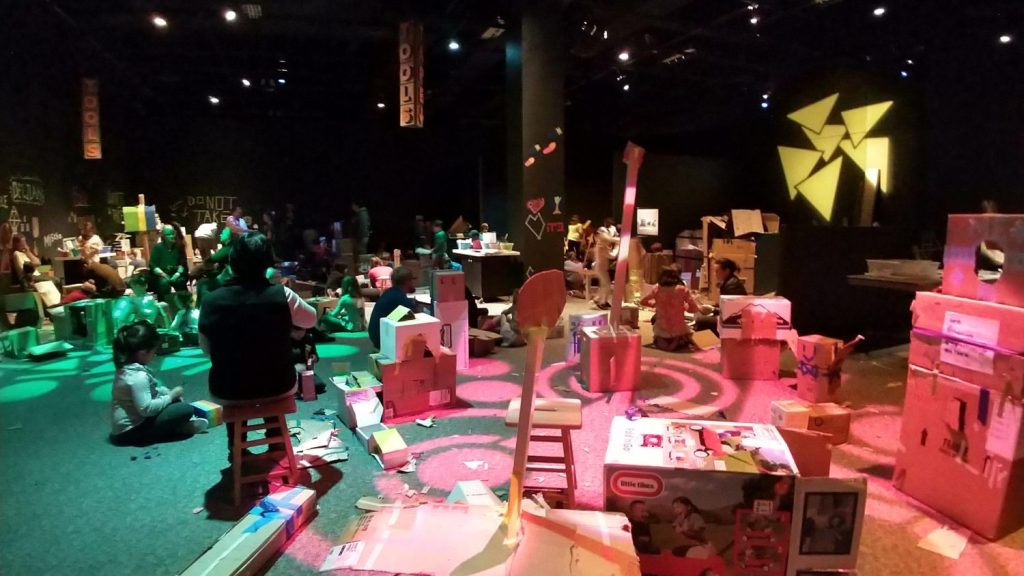
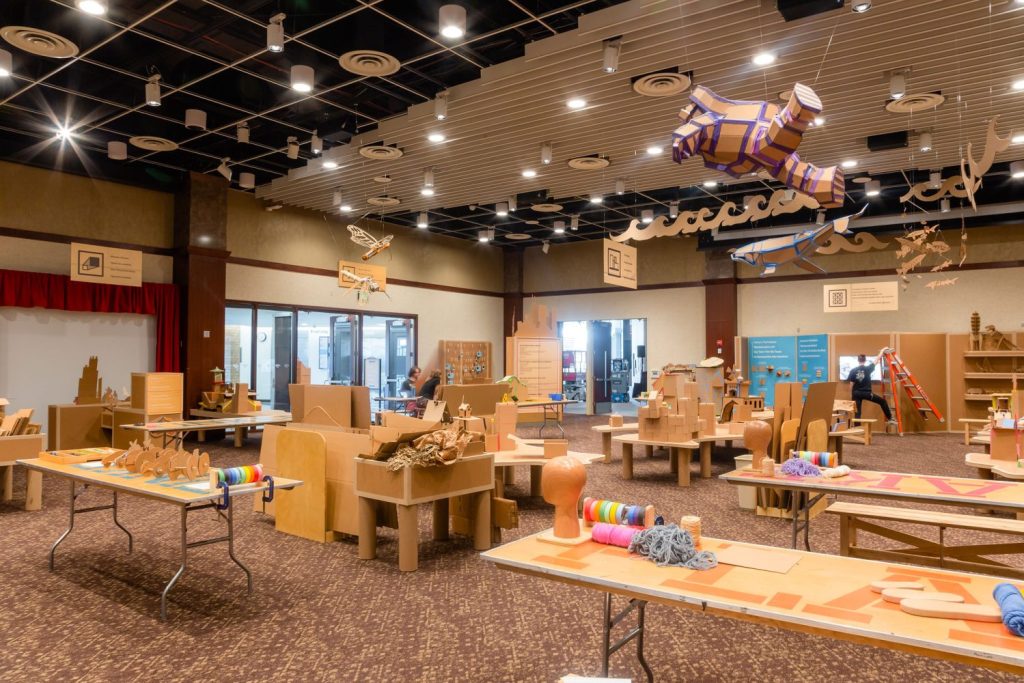
Beyond these design and fabrication expenses, the other major expense was the cost of floor staff, who were always present in Cardboard Gallery. For the first iteration in 2016, almost all the interpretive staff were drawn from SMM’s existing pool (as opposed to being new hires). Both authors worked shifts in Cardboard Gallery and can attest to how hard it was. Beyond providing visitor support and encouragement, the cleaning and recycling never ended. Abandoned projects needed to be broken down and either returned to the pile or recycled. It was constant, hard, sweaty work. In addition, there was an unexpected emotional component to the labor, as visitors who had built something earlier in their visit would return later and become upset when they discovered it had been deconstructed or remixed into someone else’s creation. The volume of things being created made it impossible to save completed projects for long. It was from the floor staff that we learned the most in terms of what to do differently–input that was essential when we restaged Cardboard Gallery in the spring of 2018 and in the multiple times the museum has repeated it since.
Cardboard City
In 2019, SMM received a grant of more than $1 million from the National Science Foundation (NSF) to continue iterating on the cardboard makerspace design and, specifically, to study design strategies to support more novice makers, including groups–such as BIPOC families–that have been excluded from the modern maker movement. Building on the success of the previous exhibitions, the most recent versions of Cardboard Gallery, now called Cardboard City, continue to embrace open-ended creativity within a loose framework and the use of examples to support inventiveness, while highlighting familiar materials–tape and cardboard–for an easy, accessible making experience (fig. 5). New features include design prompts within five thematic areas to support novice makers in generating a starting idea. For example, the “city” theme allows for easy open-building opportunities around the question, “What does a city need?” Most of the thematic areas include a way to use or display final creations, generating opportunities to test and iterate on designs or to leave creations behind to serve as examples for others.
Recognizing that these built features increased the financial requirements to open the space, and with the availability of funds from the NSF grant, museum designers prioritized sustainable reuse when creating needed exhibition components. These built elements were modularly designed so that at the end of the exhibition’s three-month run, most could be loaded into a single standard storage container and saved for eventual reuse. Additionally, smaller-scale versions of these built elements were created for use at community pop-up events. In each iteration and location, visitors have expressed the same joy, creativity, and collaboration that fueled SMM’s original Cardboard Day in 2015.
While the intent of Cardboard City was to continue staff donations of cardboard materials and to support the balanced messiness of floor-based making, the COVID-19 pandemic and resulting shifts in public perceptions of cleanliness pushed the museum into two additional happy accidents:
- First, the museum developed a workstation model where family groups worked together at their own table stocked with tape and tools. This allowed families to maintain six feet of distance between themselves and others, according to CDC guidance. After opening, visitor-facing staff expressed how much easier the space was to clean; they could visually see when a family had completed their making and “reset” the workstation without stooping to the ground. While the makerspace still required constant upkeep, workstations reduced the physical toll on staff.
- Second, with most staff working from home and cardboard being difficult to sanitize, we decided that we would only use “new” cardboard. Since purchasing tons of flat cardboard sheets was not financially feasible, we turned to our colleagues in the development department, who fostered fruitful sponsorship relationships with local and national companies based around in-kind donations of materials they were already manufacturing. These donations allowed the exhibition to remain low budget despite the quantities of new materials required for each iteration.
Conclusion
Over time, SMM has created two versions of the same exhibition: Cardboard Gallery, which, in essence, is a program that has morphed into an exhibition, and Cardboard City, which has transformed Cardboard Gallery into a more traditional, structured exhibition or makerspace. Cardboard City is significantly more expensive to produce than the original but remains less expensive than a typical, similarly scaled exhibition, particularly when built elements are reused over years and across programs. Through the lens of budget, both are highly engaging exhibitions that cost a fraction of what a typical exhibition of similar size would to produce or rent.
Through the lens of internal culture, Cardboard Gallery demonstrates not only the power of trust, experimentation, and having the space to fail, but also the importance of listening to and learning from staff at all levels of the organization. The success of the exhibition has been driven by the meaningful, ongoing engagement of SMM’s front-line staff. Their feedback and contributions have helped drive iterative changes that have not only improved their own experiences in the gallery but the experiences of visitors as well.
As a field, informal science institutions (ISIs) have promoted experimentation, failure, and what Carol Dweck has called a “growth mindset” to our visitors.[2] We encourage our visitors to take on challenges, to be curious, to see failure as a way to learn and grow, and to understand that intelligence and ability are not fixed, but rather can develop throughout our whole lives. At the same time, ISIs too infrequently foster that same growth mindset within our organizations. As the saying goes, “the cobbler always wears the worst shoes.” This exhibition was a powerful experience for the authors, as it demonstrated what is possible when an institution practices what it preaches and adopts a growth mindset that centers its staff and aligns its internal culture with its mission. Cardboard Gallery reveals that experimentation and learning from failure can look a lot like success–for staff and visitors alike.
Acknowledgements
The authors would like to thank Megan Goeke, Evaluation and Research Associate at the Science Museum of Minnesota, for her contributions to this article.
[1] See “Global Cardboard Challenge,” accessed December 13, 2022, www.cardboardchallenge.com. To view the short documentary film see, Caine’s Arcade, directed by Nirvan Mullick (Interconnected, 2012), 11 minutes, https://www.youtube.com/watch?v=faIFNkdq96U.
[2] Carol S. Dweck, Mindset: The New Psychology of Success (New York: Ballantine Books, 2006).







